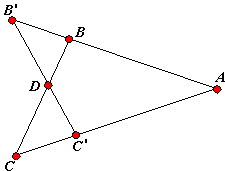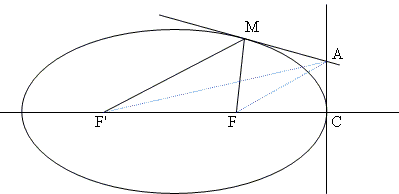Urquhart's Theorem For And By Conics
Urquhart's theorem states that, for straight lines ABB' and AC'C with BC and B'C' intersecting in D the relation

|
Michel Cabart wondered whether an "hyperbolic" version of the theorem is also true:
| Is BD - BA = C'D - C'A equivalent to B'D - B'A = CD - CA? |
What follows is the combination of Michel's emails of December 9 and 15, 2008.
Using a trigonometric approach in analogy to the "circular theorem":
| (BD - BA) / AD | = (sin2β' - sin2β) / sin2(β + β') | |
| = [sin(β' - β) cos(β' + β] / sin(β' + β) cos(β' + β) | ||
| = sin(β' - β) / sin(β' + β) | ||
| = [sinβ' cosβ - sinβ cosβ'] / [sinβ' cosβ + sinβ cosβ'] | ||
| = (t - 1) / (t + 1) |
by posing t = tanβ' / tanβ. Thus
The two variants of the theorem can be summarized into one single property: "If B and C' belong to an ellipse (resp. hyperbola), then B' and C also belong an ellipse (resp. hyperbola) with the same foci."
This suggests a proof by conics theorems. The following one (detailed for ellipse and similar for hyperbola) uses the following property of the focuses: for any two tangents MA and CA intersecting in A, FA bisects MFC and F'A bisects MF'C. Here we take CA perpendicular to the major axis.

|
Notations:
- ∠ MF'C = 2α' and ∠MFC = 2α,
- c = half the distance between foci, a = half the length of the major axis.
We then have:
|
tanα' = AC / (a + c) and tanα = AC / (a - c) |
so that
| tanα' / tanα = (a - c) / (a + c) |
Thus returning to the problem:
| tanβ' / tan(π/2 - β) | = (a - c) / (a + c) | |
| = tanγ / tan(π/2 - γ'). |
which is the condition found by trigonometric calculations.
![]()
Urquhart's Theorem
- Urquhart's Theorem
- Proof by M. Cabart
- An elementary synthetic solution
- From Leningrad Mathematical Olympiad
- Pedoe's theorem
- Pitot theorem
![]()
|Contact| |Front page| |Contents| |Geometry|
Copyright © 1996-2018 Alexander Bogomolny73581233
